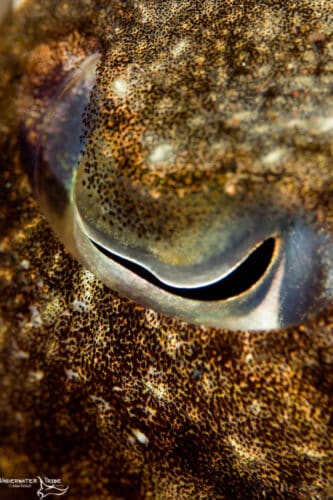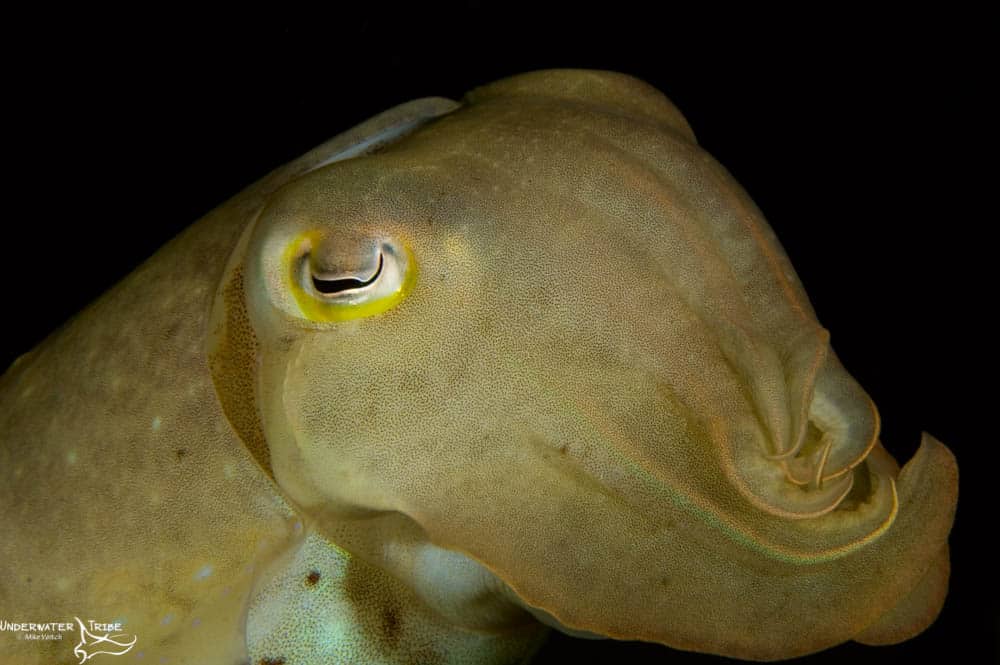Is the cuttlefish the Rodney Dangerfield of the cephalopod world? Everyone knows about octopus and squid, these charismatic critters constantly appear across all types of pop culture. Yet for some reason, the unassuming cuttlefish is a little known name to most people. A close relative to both squid and octopus, the cuttlefish is one of the most enticing and intelligent animals living in the ocean.

What is a Cuttlefish?
Cuttlefish are a type of mollusc belonging to the cephalopod order. All cuttlefish are from the Sepia family and the term Sepia is often used as the common name in many countries. Sepia is also a colour palette which originates from the ink of the cuttlefish. Found throughout tropical and temperate waters of Asia, Africa, Europe and Australia, they are not found in the Americas. Cuttlefish range in size from thumbsized to 50cm long and 10kg in weight. They have a unique looking “cuttle” bone that often washes up on beaches and individuals use it to control their buoyancy.
 Three of the most unique aspects of these amazing cephalopods are their intelligence, their eyes, and their skin. They have the largest brain size to body ratio of any invertebrate. They are able to communicate with each other through a variety of different signals including posture, skin colour, and skin texture. Their ability to change their appearance rapidly is almost unrivaled in the animal world. These patterns aid in hiding from prey and predators as well as “talking” to potential mates or rivals. Their eyes are complex and they are able to see a full 360 degrees.
Three of the most unique aspects of these amazing cephalopods are their intelligence, their eyes, and their skin. They have the largest brain size to body ratio of any invertebrate. They are able to communicate with each other through a variety of different signals including posture, skin colour, and skin texture. Their ability to change their appearance rapidly is almost unrivaled in the animal world. These patterns aid in hiding from prey and predators as well as “talking” to potential mates or rivals. Their eyes are complex and they are able to see a full 360 degrees.
Hunting, Venom, and Reproduction
Cuttlefish are voracious predators. They eat a variety of shrimp, crabs, and even small fish or other cephalopods. They have 8 arms and 2 unique tentacles that act as a fast grasping feeding arm. When they spot potential prey this special tentacle whips out in a quick strike which easily extends the length of their body. One interesting fact about these cousins of octopus is that a few species are venomous. In fact, the adorable looking flamboyant cuttlefish is known to boast a venom as toxic as the blue ring octopus.
 Males and females mate face to face with the male using its tentacles to insert sperm sacs into an orifice of the female. The female lays her eggs in variety of environments. Locations such as hard corals, under rocks, or even inside empty coconuts are common sites to see these marble sized eggs. The young hatch fully formed and are instantly on the hunt for food and protection. Even as hatchlings, cuttlefish are able to “ink” at any sign of danger in order to confuse predators. This behaviour is common with all cephalopods as ruse to escape hostile situations.
Males and females mate face to face with the male using its tentacles to insert sperm sacs into an orifice of the female. The female lays her eggs in variety of environments. Locations such as hard corals, under rocks, or even inside empty coconuts are common sites to see these marble sized eggs. The young hatch fully formed and are instantly on the hunt for food and protection. Even as hatchlings, cuttlefish are able to “ink” at any sign of danger in order to confuse predators. This behaviour is common with all cephalopods as ruse to escape hostile situations.
Where to Find Cuttlefish in Indonesia
In Indonesia, we see many different species in a variety of environments. Black sand slopes are great places to find several varieties of them including the beautiful flamboyant cuttlefish. The fist sized crinoid cuttlefish likes to hide in rocky environments or within a grove of crinoids. The larger reef cuttlefish live in and around coral gardens throughout all reef environments in Indonesia. In Bali, we spot these fascinating cephalopods throughout the year on almost every dive site.
Have you ever encountered a cuttlefish? Let us know in the comments about your encounter with these intelligent and fascinating animals.



